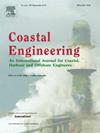Assessing shorelines extracted from satellite imagery using coincident terrestrial lidar linescans
IF 4.5
2区 工程技术
Q1 ENGINEERING, CIVIL
引用次数: 0
Abstract
Numerous algorithms have been developed to facilitate the extraction of shoreline position from satellite imagery, including the CoastSat algorithm. Previous analyses comparing CoastSat satellite-derived shorelines (SDS) to morphological data have highlighted that there are site-specific errors in outputs that are likely related to concurrent wave runup conditions, but the data required to test this relationship are rarely available. Here, we present a novel comparison of lidar-derived runup and beach elevation data to CoastSat satellite-derived waterlines (SDW) extracted using two image sources (Sentinel-2 and PlanetScope) and two threshold algorithms (Otsu and weighted peaks). Results show that while SDW extracted using Otsu thresholds correlated better with lidar-derived waterlines (LDW), SDW extracted using the weighted peaks threshold were consistently positioned in the upper swash and therefore correlated better with a runup bulk statistic. Assigning the best-fit runup bulk statistic as the waterline elevation to weighted peaks SDW resulted in SDS with less scatter than the Otsu SDW due to the more consistent waterline elevation. Horizontal errors for the converted datum-referenced shoreline were lowest when SDW were converted to SDS using best-fit measured runup bulk statistics and a measured slope. However, for weighted peaks SDW from both image sources, assigning the best-fit parameterized runup bulk statistic and an average slope in the SDW to SDS conversion still reduced error by to when compared to the tidal elevation and average slope. These findings confirm that runup corrections can improve native SDS outputs, although the magnitude of the final shorelines error depended on the specific imagery product, local beach slope, threshold technique, runup parametrization, and chosen reference contour.
使用同步地面激光雷达线扫描仪评估从卫星图像中提取的海岸线
为了方便从卫星图像中提取海岸线位置,已经开发了许多算法,包括海岸卫星算法。先前对海岸卫星岸线(SDS)与形态数据进行的比较分析强调,输出结果中存在特定地点的错误,这些错误可能与同步波浪上升条件有关,但测试这种关系所需的数据很少可用。在这里,我们提出了一种新颖的比较方法,将激光雷达衍生的上升和海滩高程数据与使用两种图像源(Sentinel-2和PlanetScope)和两种阈值算法(Otsu和加权峰值)提取的海岸卫星衍生水线(SDW)进行比较。结果表明,虽然使用Otsu阈值提取的SDW与激光雷达衍生水线(LDW)的相关性更好,但使用加权峰值阈值提取的SDW始终定位于上部冲刷,因此与堆积统计数据的相关性更好。将最佳拟合汇总统计量作为水线高程分配给加权峰值SDW,由于水线高程更一致,SDS比Otsu SDW具有更少的散点。当SDW转换为SDS时,使用最合适的测量累积量统计和测量斜率,转换后的基准参考海岸线的水平误差最低。然而,对于来自两个图像源的加权峰值SDW,与潮汐高程和平均坡度相比,将SDW中的最佳拟合参数化累积量统计量和平均坡度分配给SDS转换,仍然可以将误差降低~ 20%至~ 35%。这些发现证实,尽管最终海岸线误差的大小取决于特定的图像产品、当地海滩坡度、阈值技术、上升参数化和所选的参考轮廓,但上升校正可以改善本地SDS输出。
本文章由计算机程序翻译,如有差异,请以英文原文为准。
求助全文
约1分钟内获得全文
求助全文
来源期刊

Coastal Engineering
工程技术-工程:大洋
CiteScore
9.20
自引率
13.60%
发文量
0
审稿时长
3.5 months
期刊介绍:
Coastal Engineering is an international medium for coastal engineers and scientists. Combining practical applications with modern technological and scientific approaches, such as mathematical and numerical modelling, laboratory and field observations and experiments, it publishes fundamental studies as well as case studies on the following aspects of coastal, harbour and offshore engineering: waves, currents and sediment transport; coastal, estuarine and offshore morphology; technical and functional design of coastal and harbour structures; morphological and environmental impact of coastal, harbour and offshore structures.
 求助内容:
求助内容: 应助结果提醒方式:
应助结果提醒方式:


